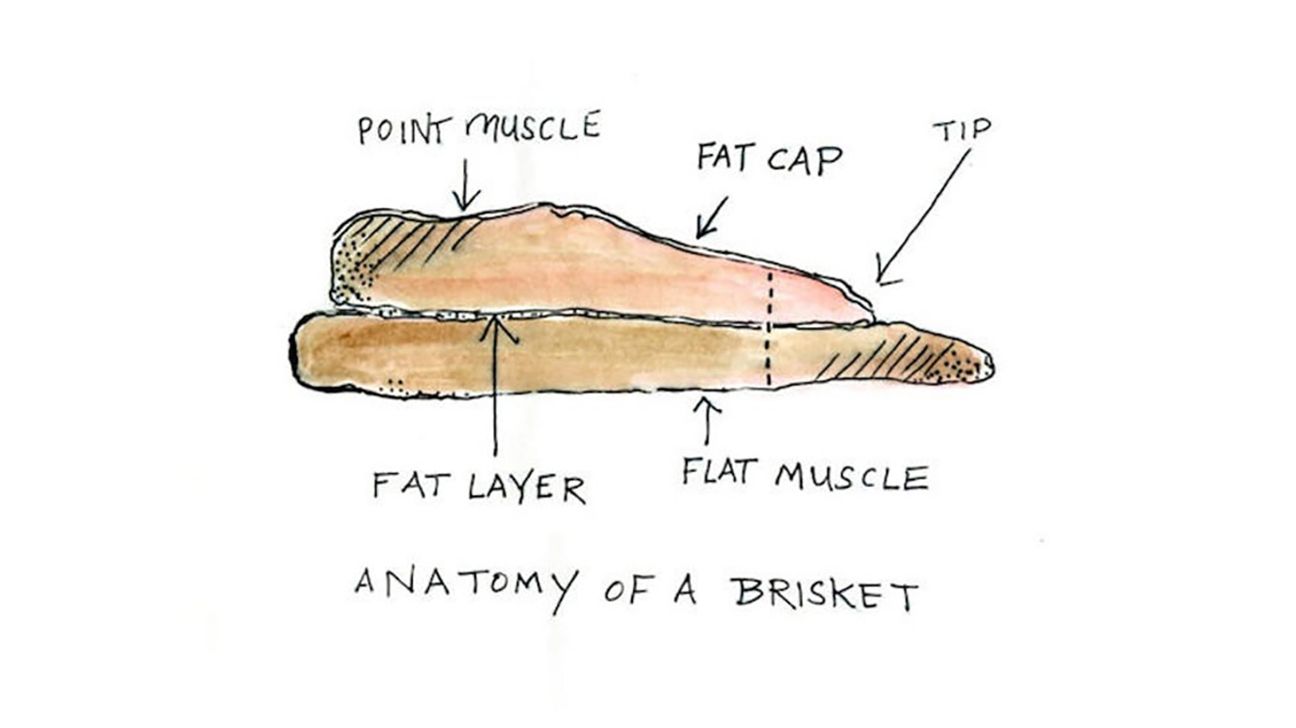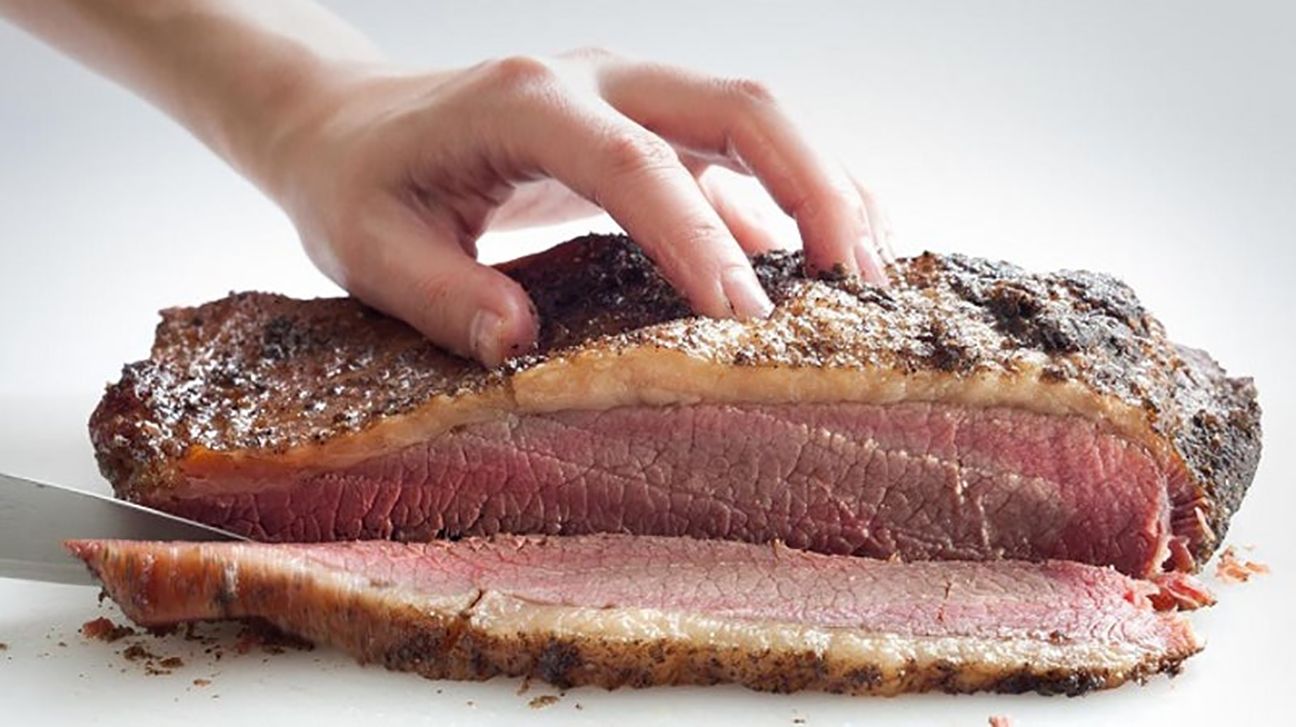Maybe you’ve never wondered, “What is the difference between brisket and Texas brisket?” — maybe you didn’t even know there were multiple types of brisket. But there is a difference, and it’s all in the cut. Find out more about the finer points of brisket, with side trips into corned beef and pastrami, burnt ends, and even barbacoa.

Brisket is cut from the breast section of a cow, just below the chuck; there are two briskets per carcass, and each brisket consists of two distinct areas separated by a layer of fat. The point (also called the deckle) is the richly marbled, fatty section of meat that sits on top of what is called the flat, the bigger, leaner bottom section, which also has a more even thickness.
If you’re browsing the meat section of the average grocery store, the 2- to 6-ish-pound hunk of meat you’ll usually find labeled “brisket” is most likely a trimmed flat (also called the first cut). This is the cut for slow cooking and braising in your Crock-Pot or Dutch oven, and other moist heat cooking methods; if you smoked it for hours and hours like a Texas brisket, it would have the textural appeal of leather.
It’s rare to find the point or deckle sold separately, but you’re more likely to see it around St. Patrick’s Day because it’s an ideal cut for corned beef. The higher amount of marbling (i.e. intramuscular fat running through the meat) will help keep it tender as it’s braised for hours, and impart more flavor. You’ll probably want to peel off the really big pockets of jiggly connective tissue once the meat is cooked, but by then it will have served its purpose anyway. If you prefer a leaner start, go with the flat.
The point is also the piece you remove from a cooked brisket to make burnt ends (more on that below).
When you’re talking Texas brisket, you’re talking about a full, packer brisket (i.e. the entire cut, with both point and flat sections intact) that weighs anywhere from 8 to 12-plus pounds. This is what pitmasters smoke at “low and slow” temperatures (225°F to 250°F) via indirect heat for 8 or more hours for classic BBQ brisket—meat that is tender and imbued with a smoky flavor so delicious there’s no need for barbecue sauce (although that never hurts).
You can use a full Texas brisket or packer brisket for making other dishes that are braised or slow cooked if you like, but if you have the time and the tools, its highest calling truly is barbecue.
Below are just some of the many fabulous ways to enjoy your brisket, and there’s something for all palates—and levels of patience. Plus, see what to do with leftover brisket.
Texas-Style Smoked Brisket
Here’s the dirty little secret about Texas-style smoked brisket: Most formal “recipes” are bogus because they focus on some fancy brisket rub or sauce and give you zero guidance in setting up your charcoal or wood smoker and running it between 225°F and 250°F for eight or more hours. If you’ve never actually cooked a full, packer cut brisket or run a smoker for half a day, Aaron Franklin’s no-frills breakdown is a great place to start. He is the man behind the famous Franklin Barbecue in Austin, so he knows what he’s talking about. Get the Texas-Style Smoked Brisket recipe. And get more Smoked BBQ Brisket tips and tricks.
Easy Slow Cooker BBQ Beef Brisket
For the cooks who will never attempt a Texas brisket, nor lose any sleep over this fact, this is your pitch-perfect, fall-apart-tender brisket recipe. Some of us would prefer you not ever refer to the outcome as “barbecue,” but the same “us” would gladly accept an invite to eat this at your house, anytime. Get our Easy Slow Cooker BBQ Beef Brisket recipe.
Grandma Irma’s “California” Brisket
Food snobs, take note. There’s much to love about this back-of-the-box recipe, and it starts with Irma, who was too busy bringing home the bacon in the ’70s (protesting the Vietnam War and fighting for equal rights) to fuss over artisanal, frou-frou ingredients. We also love producing a melting-tender brisket in less than three hours (that’s just as tasty served as a plated dinner or sliced for a sandwich). It’s a good reminder of why we cook: to feed the people we adore, but more importantly, to have the time to enjoy their company. Get Grandma Irma’s “California” Brisket recipe.
Red Wine Braised Beef Brisket
Still, if you want to go a little more highbrow than Grandma Irma’s brisket, this is how you get there. (It takes a full bottle of wine, so be sure to get another one to drink along with.) Get the Red Wine Braised Beef Brisket recipe.
Burnt Ends
Burnt ends happen when a pitmaster surgically removes the point from a smoked brisket, cuts it into cubes, and tosses those cubes back on the cooker in a pan, where they turn into spicy, charred, fatty nuggets of bliss. When you’ve aced the art of the Texas-style smoked brisket, burnt ends are the next step in barbecue bravado. If you’re not cooking a full brisket, keep an eye out for point cuts (ask your butcher to save a few) and you can make burnt ends from scratch—perfect if your favorite part of smoked meat is always the bark. Get the BBQ Brisket Burnt Ends recipe.
Oven-Smoked Pastrami
There’s no easy way to say this: Making pastrami is not for weenies. It is a time-consuming endeavor that requires a huge hunk of brisket, a few special ingredients, and some MacGyver-ing in the kitchen. Truthfully, though, it’s not laborious; most of the time involved is just you waiting 10 days while the meat cures in the spice mix. And you can skip the oven-smoking rig if you own a smoker or large kettle-style grill that can be set up for indirect cooking. Get our Oven-Smoked Pastrami recipe.
Slow-Cured Corned Beef Brisket
Yes, you can make a St. Patrick’s Day corned beef with the eye of round, but what would your ancestors think? The point cut is traditional (although a trimmed 5-pound packer cut would work fine, too) and yields fatty, seasoned slices perfect for a sandwich year-round. Get our Slow-Cured Corned Beef recipe.
Slow Cooker Barbacoa Beef Brisket
Brisket does well in the slow cooker, as we’ve already established, but slathering it in barbecue sauce isn’t your only option. Try a Mexican brisket with chipotle, garlic, cumin, and oregano, and pile those juicy chunks into tortillas for some of the best tacos you’ve ever had. Get the Slow Cooker Barbacoa Beef Brisket recipe.
Chinese Brisket and Turnip Stew
Truly a world traveler, brisket is great in classic Chinese dishes too; this one is a tender braise fragrant with ginger, star anise, garlic, and chu hou paste. Serve it with vermicelli noodles for a new favorite winter stew. Get the Chinese Brisket and Turnip Stew recipe.
Bulgogi Brisket Sliders
Marinating brisket in the flavors of Korean bulgogi makes for a super delicious slider, especially when the beef is paired with spicy mayo, spicy pickles, and a tangle of fresh scallions. It’s like a lettuce wrap but even better (at least if you like buttered, toasted buns). Get the Bulgogi Brisket Slider recipe.

